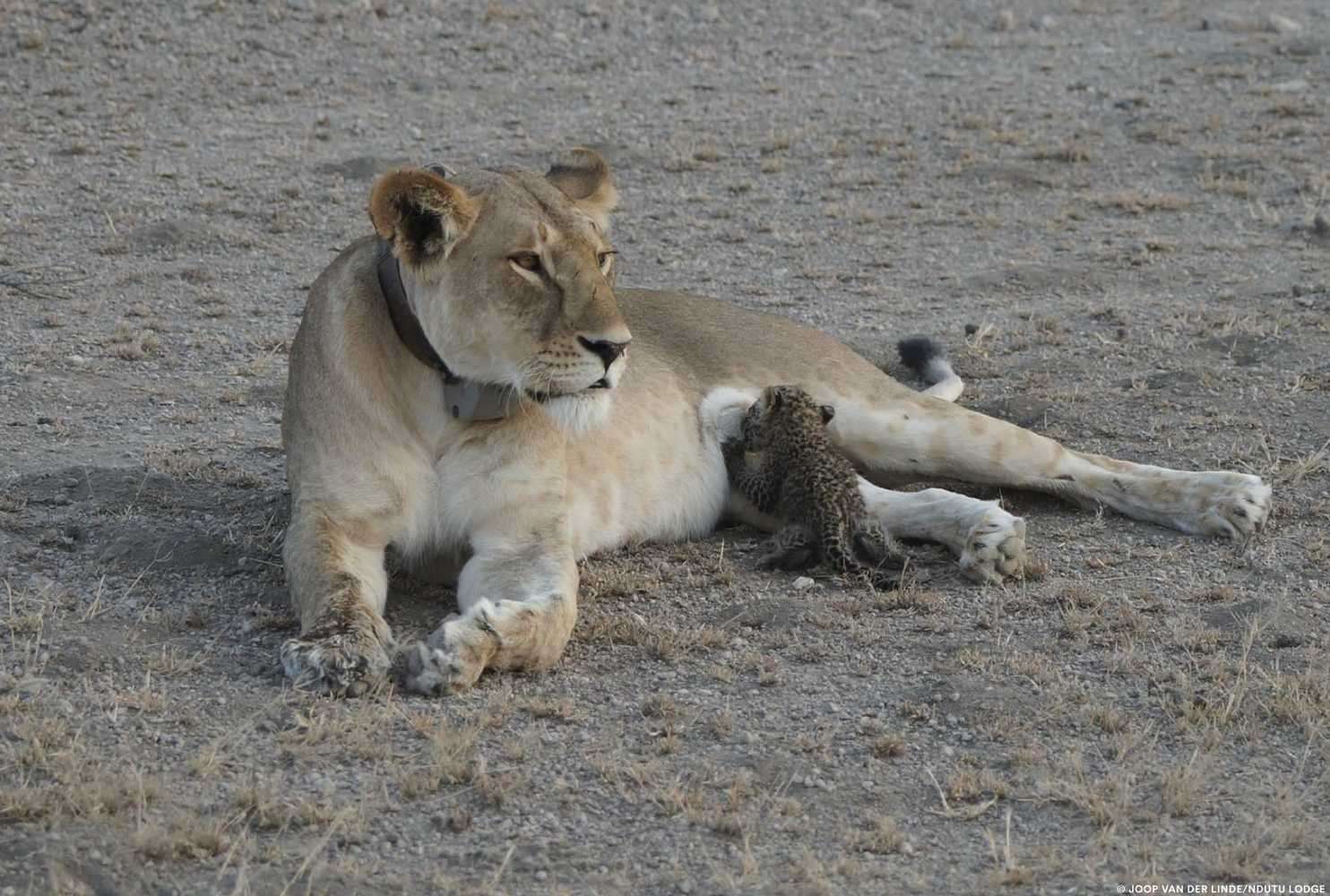A leopard cub nurses from a lioness known as Nosikitok in Tanzania’s Ngorongoro Conservation Area. (Courtesy of Panthera)
Luke Hunter, president and chief conservation officer of the global wild cat organization Panthera, received an email this week from one of his group’s partners in Tanzania. When he opened the attached photos, Hunter recalled, “my jaw just dropped.”
The images show a lioness lounging on a flat, dry spot in the Serengeti. Attached to her is a nursing cub — and the cub is a tiny, spotted leopard.
This is the sort of sighting that is pretty much mind-blowing to lion experts like Hunter. Interspecies suckling has been documented among captive animals, and on very rare occasions wild carnivores such as leopards and pumas have been known to adopt an orphaned cub of their own kind, usually one that is related. But never before has interspecies suckling among large carnivores been recorded, Hunter said (and he checked the literature).
“It’s unprecedented,” he said, almost gushing. “It’s a once-in-a-lifetime event.”
“My jaw just dropped,” upon seeing the photos, a lion expert said. (Courtesy of Panthera)
The leopard cub appears to be about 3 weeks old, said Luke Hunter, president and chief conservation officer of Panthera. (Courtesy of Panthera)
The photos were taken Tuesday by a guest at the Ndutu Lodge in the Ngorogoro Conservation Area, where KopeLion, which Panthera supports, works on quelling conflicts between lions and local farmers whose livestock sometimes become lion lunch. KopeLion monitors the area lions, which is why the nursing mom in the photos is wearing a GPS collar.
The lioness is known as Nosikitok, and, importantly, she is known to have given birth to three cubs of her own in late June. That means “she is absolutely awash with maternal hormones and that instinct to take care of her own babies,” Hunter said. “This simply wouldn’t have happened if she wasn’t suckling her own babies.”
Typically, he elaborated, a lioness would kill a baby leopard. That’s because the baby, while very small and terribly adorable, is just another meat-eating competitor in a wild, sometimes severe world.
“Lions kind of go out of their way to get rid of them,” he said of other carnivores.
It’s unclear whether the nursing session was a one-off or whether Nosikitok “adopted” the leopard cub. (Courtesy of Panthera)
But Nosikitok’s hormones hardly explain everything about this peaceful encounter, Hunter said. For one, it’s unclear where the leopard cub’s mother was or whether she is alive. Also unknown is whether Nosikitok’s own cubs were safe in their den, about half a mile away, or whether she’s already lost them to predators, starvation or other common lion cub killers. As of Thursday morning, her collar positioned her neither in the den where her own cubs might be nor in the spot where she fed the leopard cub.
This story, however, isn’t likely to have a happy ending for the wee leopard, which Hunter said appears to be about 3 weeks old. Lionesses break away from their prides to give birth, then usually introduce new cubs to the family when they’re about 8 weeks old — if the little ones make it to that age, Hunter said. On the very off-chance Nosikitok decided to adopt the spotted babe and managed to keep it alive long enough to take it home, her crew probably would not be so welcoming.
“That would be the most fascinating encounter to observe,” Hunter said. But, he added: “I would love for this to end nicely. But I think the challenges facing the little leopard cub are formidable.”
This leopard cub’s fate isn’t likely to be happy, Hunter said. (Courtesy of Panthera)
Why goats used to breast-feed human babies
Yes, those cuddling lions are male. But that doesn’t mean they’re gay.
This bobcat brings in $308,000 a year
Polar bears hurt by climate change are more likely to turn to a new food source — humans
Now we know why a beloved Yellowstone grizzly was killed

HumanArms on July 14th, 2017 at 02:11 UTC »
A guy named Hunter is the animal conservation person
AssaultnPepper on July 14th, 2017 at 00:27 UTC »
If you like happy endings, do not read the article. Read the title, say "Aww" and then click on.
Havajava on July 14th, 2017 at 00:11 UTC »
If the baby is almost certain to be killed, couldn't they rescue it and send it to rehabilitation shelter?